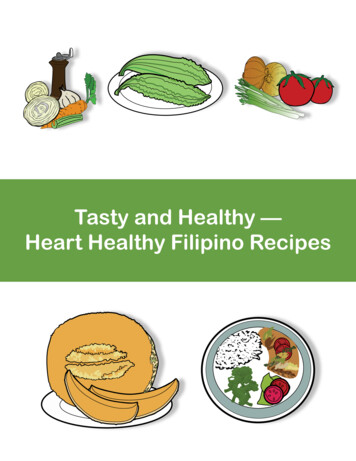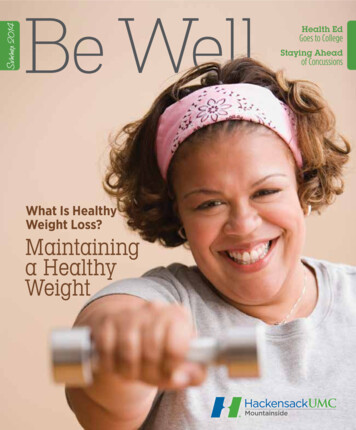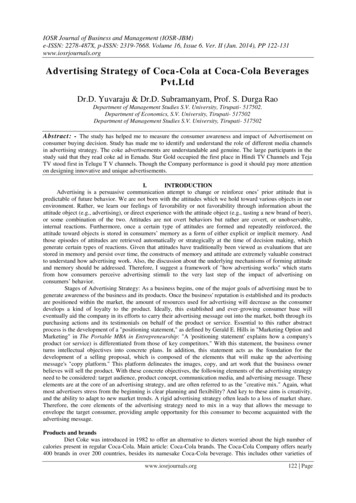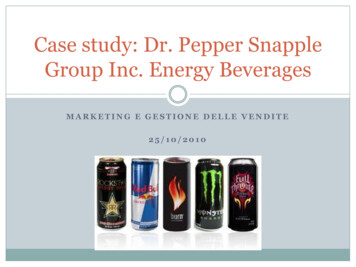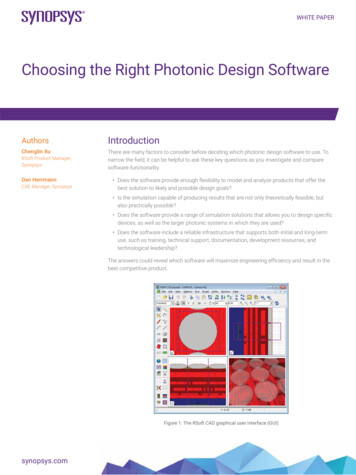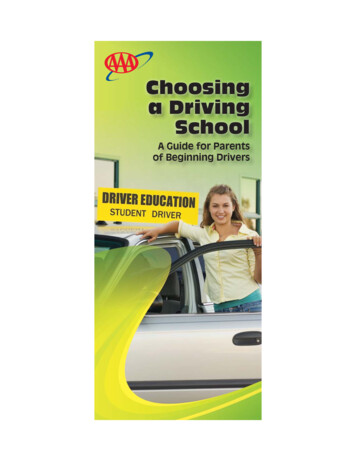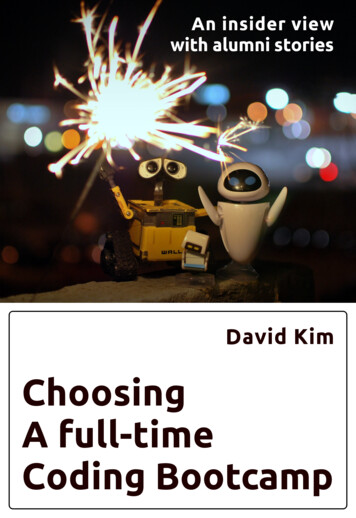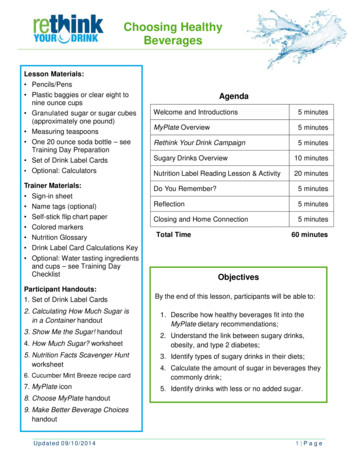
Transcription
Choosing HealthyBeveragesLesson Materials: Pencils/Pens Plastic baggies or clear eight tonine ounce cups Granulated sugar or sugar cubes(approximately one pound) Measuring teaspoons One 20 ounce soda bottle – seeTraining Day Preparation Set of Drink Label Cards Optional: CalculatorsTrainer Materials: Sign-in sheet Name tags (optional) Self-stick flip chart paper Colored markers Nutrition Glossary Drink Label Card Calculations Key Optional: Water tasting ingredientsand cups – see Training DayChecklistParticipant Handouts:1. Set of Drink Label Cards2. Calculating How Much Sugar isin a Container handout3. Show Me the Sugar! handoutAgendaWelcome and Introductions5 minutesMyPlate Overview5 minutesRethink Your Drink Campaign5 minutesSugary Drinks Overview10 minutesNutrition Label Reading Lesson & Activity20 minutesDo You Remember?5 minutesReflection5 minutesClosing and Home Connection5 minutesTotal Time60 minutesObjectivesBy the end of this lesson, participants will be able to:1. Describe how healthy beverages fit into theMyPlate dietary recommendations;4. How Much Sugar? worksheet2. Understand the link between sugary drinks,obesity, and type 2 diabetes;5. Nutrition Facts Scavenger Huntworksheet3. Identify types of sugary drinks in their diets;6. Cucumber Mint Breeze recipe card4. Calculate the amount of sugar in beverages theycommonly drink;7. MyPlate icon5. Identify drinks with less or no added sugar.8. Choose MyPlate handout9. Make Better Beverage ChoiceshandoutUp d at ed 0 9/ 1 0/ 2 01 41 Page
Training Day Preparation:1. Make copies of participant handouts2. Prepare sign in sheets and nametags3. Collect Lesson and Trainer materials4. Prepare display bottle: Empty and wash 20 ounce soda bottle andcap. Allow to dry completely. Remove label from bottle and replace withNutrition Facts label from Drink LabelCards for 20 ounce soda. Fill bottle with 17 teaspoons of sugar orsugar cubes and recap.Optional Display Materials andHandouts Sugar Synonyms poster Beverages: Make EverySip Count handout How Much Sugar is in YourDrink poster Information about upcomingnutrition education opportunitiesTraining Day Checklist1. Sign-in sheet and nametags2. Participant handouts (see list)3. Lesson and Trainer materials (see lists)4. Set up sugar, measuring spoons andbaggies/cups on a table at the front5. Optional: Set up water tastingCucumber Mint Breeze1 cucumber, washed and sliced1 bunch mint, washedIceWaterPitcher or dispenserTasting Cups1. Put half of ice in dispenser/pitcher.2. Add lightly crushed mint leaves and slicedcucumber on top of ice.3. Top with more ice, and then fill with water.4. Serve with tasting cups during breaks.Note: Flavor gets stronger the longer itsits! Refill as needed.Up d at ed 0 9/ 1 0/ 2 01 42 Page
PRESENTER NOTESPRESENTER SCRIPT5 minutesWelcome & IntroductionsIntroduce yourself and share ashort professional background ofyourself and your organization.Optional: Ask the participants tointroduce themselves.Thank you all for joining me today.Today’s topic is sugary drinks. You will learn about:1. How healthy beverages fit into the MyPlate dietaryrecommendations;2. The link between sugary drinks, obesity, and type 2diabetes;3. Types of sugary drinks that may be in your diet;4. How to calculate the amount of sugar in beverages;5. Healthy beverages you and your family can drink.5 minutesIntroduce participants to MyPlateand the five food groups (Fruit,Vegetable, Grain, Protein Foods,and Dairy) by displaying thecolorful MyPlate icon.Invite participants to share whatthey observe about theMyPlate icon.Showcase to participants thathalf of the plate should be fruitsand vegetables.MyPlate OverviewMaterials: MyPlate icon Choose MyPlate handoutLet’s begin with MyPlate. The MyPlate icon serves as areminder that a person should eat foods from the five foodgroups each day.By eating a variety of foods from each food group, we giveour bodies what they need to be and stay healthy.Do you notice any differences in the food groups shown onthe MyPlate icon?The portion sizes of each group are slightly differentbecause we need different amounts from each food group.For example, we need more vegetables than fruit.PRESENTER NOTESPRESENTER SCRIPTPRESENTER NOTESPRESENTER SCRIPTUp d at ed 0 9/ 1 0/ 2 01 43 Page
PRESENTER NOTESPRESENTER SCRIPTObjective #1Describe how healthy beveragesfit into the MyPlate dietaryrecommendationsNotice that the beverage served with meals is milk. Thelowest in fat are lowfat 1% and non-fat milk, and thereforethey are better choices.In each food group, there are healthier foods that we shouldchoose more often. These foods contain a lot of nutrientsbut not a lot of added sugars or solid, or saturated, fats.Reference the Choose MyPlatehandout.The Choose MyPlate handout will help you and your familieschoose to eat these healthier foods more often.5 minutesRethink Your Drink CampaignThere are some foods and beverages made up almostentirely of added sugar and/or solid fats. In fact, these foodsand beverages do not contain enough of any nutrients to putthem into any food group within MyPlate.Transition from MyPlateintroduction to Rethink YourDrink CampaignWait for responses.Introduce the Rethink Your DrinkCampaign from the CaliforniaDepartment of Public HealthUp d at ed 0 9/ 1 0/ 2 01 4We’re going to learn a few skills today that will help us toidentify these foods and beverages so that we can begin tomake healthy choices for ourselves and for our families.Who here can share with the group if they have heard aboutthe Rethink Your Drink Campaign, and what they knowabout it?The Rethink Your Drink Campaign: Educates Californians about healthy drinks, Helps Californians recognize the amount of added sugarand calories in sugary drinks, Communicates the link to health risks.4 Page
PRESENTER NOTESPRESENTER SCRIPTIntroduce health consequences.Why? Extra calories from added sugar—like those in sugarydrinks—can and do contribute significantly to overweightand obesity. In fact, sugary drinks are the largest source ofObjective #2Understand the link betweensugary drinks, obesity, andtype 2 diabetesadded sugar in the American diet.1Sugary drinks contribute to increased risk for certain chronicdiseases such as type 2 diabetes and heart disease.2,3Drinking sugary drinks nearly doubles the risk of dentalcavities in children.4Plus, strong evidence shows that children and adolescentswho consume more sugary drinks have higher body weightcompared to those who drink less.5Sugary Drinks Overview10 minutesMaterials: Make Better Beverage Choices handout Flip chart & markersObjective #3 Identify types ofsugary drinks in their dietsWhat are sugary drinks?Wait for responses.Who can share an example of a sugary drink in their diet?If a participant mentions aspecific branded product, affirmtheir participation and name thetype of sugary drink it is.Up d at ed 0 9/ 1 0/ 2 01 4Thank you for participating. That particular brand that youmentioned is a type of sugary drink called.Can anyone else think of another type of drink that hasadded sugar?5 Page
PRESENTER NOTESPRESENTER SCRIPTAre there any others?Types of sugary drinks that may be named:List the types of drinks that arecalled out on the flip chart pad.Facilitate discussions duringlulls in class participation byoffering suggestions from thetable at right.Wait for responses.Soda/Soda popSports drinksEnergy drinksJuice drinksFlavored milk (e.g., chocolate,strawberry, vanilla)Coffee drinks (hot or iced)with sweeteners or flavoringBlended coffee drinksMochaVitamin-added watersMilk teaBoba/ Bubble/ Pearl tea ordrinkSweetened teas (hot oriced)HorchataAgua frescaYogurt drinksGrass jelly drinksHow many of you are surprised by some of drinks consideredsugary drinks?The number of types of sugary drinks is amazing!It is important to address sugary drinks because as mentioned,there’s a link between sugary drinks and overweight, obesity,and type 2 diabetes. Many sugary beverages offer calories, butprovide few nutritional benefits. Some other facts to consider:Be sure to choose facts towhich your audience can relate. In California, 62% of adolescents, 41% of children and 24%6of adults drink one or more sodas per day. Each year, the average California adolescent consumes the6equivalent of 39 pounds of sugar from sugary drinks. And, adults who drink one or more sugary drinks a day are27% more likely to be overweight than adults who do notdrink sugary drinks.Up d at ed 0 9/ 1 0/ 2 01 466 Page
PRESENTER NOTESPRESENTER SCRIPTNow we know what sugary drinks are, how they affect ourhealth, and that too many sugary drinks are consumed.So what can we do to change our consumption patterns?Make Better Beverage ChoiceshandoutToday we’re sharing with you “Make Better BeverageChoices – 10 Tips to get Started” from thewww.MyPlate.gov website.You can see here on the handout, tip #9 says, “Check theFacts: Use the Nutrition Facts label to choose beverages atthe grocery store. The label contains information about totalsugars, fats, and calories to help you make better choices.”So let’s do that!Transition to the skill-buildingportion of the lessonLet’s discuss how much sugar is in some of the mostpopular drinks by reading their nutrition label andcalculating the amount of sugar they contain.Nutrition Label Reading Lesson & ActivityMaterials:20 minutesUp d at ed 0 9/ 1 0/ 2 01 4 20 ounce prepared display bottle (see Training DayPreparation) Calculating How Much Sugar is in a Container handout Show me the Sugar! handout Sugar Synonyms poster (optional) Drink Label Cards How Much Sugar? worksheet Pens/pencils Calculators (optional) Granulated sugar or sugar cubes Measuring teaspoons Plastic baggies or clear eight or nine ounce cups7 Page
PRESENTER NOTESPRESENTER SCRIPTWait for responses.How many teaspoons of sugar do you think is in a typical20 ounce bottle of soda?After participants guess, showthem the prepared display bottlefilled with sugar. Pass the displaybottle around the class.Objective #4Calculate the amount of sugar inbeverages they commonly drinkAnswer: A typical 20 ounce bottle of soda can have as muchas 14 teaspoons of sugar, or even more.This bottle has 14 teaspoons of sugar.I’d like to show you how you can find out how much sugaris in a beverage by teaching you how to read a NutritionFacts label.By the way, this is also a great exercise to do with yourfamily the next time you’re shopping for groceries.Please get into pairs or small groups of 3-4 people.Calculating How Much Sugar is in a ContainerCalculating How Much Sugar isin a Container handoutPlease refer to the Calculating How Much Sugar is in aContainer handout.Can someone tell the class, what is the serving size listed inthe Nutrition Facts label?Wait for responses.Answer: This label lists 20 fluid ounces as the serving size.Can someone tell the class, how many servings per containerare listed in this Nutrition Facts label?Wait for responses.Up d at ed 0 9/ 1 0/ 2 01 4Answer: This label lists one serving.8 Page
PRESENTER NOTESPRESENTER SCRIPTHow much sugar is listed?Wait for responses.Answer: There are 68 grams of sugar listed in this label.Let’s see how many teaspoons that actually is.To do that, divide the grams of sugar by four to get the totalteaspoons of sugar.Grams of Sugar 4 Teaspoons of SugarOptional: Participants can use acalculatorThis example has 68 grams of sugar. So:68 grams of sugar 4 17 teaspoons of sugar.Note that this bottle is only one serving. However, if thecontainer lists more than one serving, you would need tomultiply the number of teaspoons of sugar by the number ofservings in the container to get the total teaspoons of sugarin the entire container.For example,17 teaspoons of sugar x 2 servings in the container 34 teaspoons of sugar in the container.We just learned how to calculate the number of teaspoonsof sugar in a beverage. These same calculations work onfood as well. You can do this with any Nutrition Facts label.Next, we’ll look at the Ingredients list; but before we do thislet’s talk briefly talk about the different types of sugar:Types of sugarSugar comes in many forms and has many names. Thoughnot listed separately on the Nutrition Facts label, manydrinks contain two types of sugar: naturally occurring sugarand added sugar.Up d at ed 0 9/ 1 0/ 2 01 49 Page
PRESENTER NOTESPRESENTER SCRIPTNaturally occurring sugars are found naturally in fruits(fructose) and milk (lactose). These sugars are part of theoverall healthy package of nutrients that these foods provide.Added sugars, however, add calories but no nutrients tofoods. Added sugars are found mainly in processed foodsand drinks.That’s why we are encouraged to eat foods with lessadded sugars.Show me the Sugar! handoutOptional: Refer to SugarSynonyms posterOne way to know if there is sugar (added, natural, or both) isto read the ingredients list on the label. Names of naturallyoccurring sugars include: Fructose Lactose Maltose Glucose (aka dextrose) SucroseNames of added sugars frequently found in the ingredientslist of foods and beverages include:Refer to Sugar Synonyms posteror write names on flip chart pad. Invert sugar Brown sugar Corn syrup Raw sugar High fructose corn syrup Honey Malt syrup Maltodextrin Maple syrup MolassesCheck the ingredients list of a beverage or snack.If a type of sugar is in the first three ingredients, the productis likely to have a lot of added sugars.Up d at ed 0 9/ 1 0/ 2 01 410 P a g e
PRESENTER NOTESPRESENTER SCRIPTHow Much Sugar?Let’s take a closer look at the sugar that is in a few populartypes of drinks.Provide each group with One Drink Label Card How Much Sugar? worksheet A pen and/or pencil Calculator (optional)Set up a table at the front of theclass with: Granulated sugar or sugarcubes Measuring teaspoon Plastic baggies or clear eightto nine ounce cups.Have one participant from eachgroup:1. Share the information on theirsheet;2. Measure out the number ofteaspoons of sugar into thebaggi
Nutrition Glossary Drink Label Card Calculations Key Optional: Water tasting ingredients and cups – see Training Day Checklist . Participant Handouts: 1. Set of Drink Label Cards . 2. Calculating How Much Sugar is in a Container . handout. 3. Show Me the Sugar! handout 4. How Much Sugar? worksheet . 5. Nutrition Facts Scavenger Hunt. worksheet. 6. Cucumber Mint Breeze recipe card
